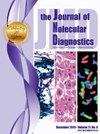Comparison of Targeted RNA-Sequencing Platforms for Oncogenic Fusion Detection in Non–Small-Cell Lung Cancer
IF 3.4
3区 医学
Q1 PATHOLOGY
引用次数: 0
Abstract
Oncogenic fusion detection is an essential part of clinical diagnosis and management of non–small-cell lung carcinoma. Numerous methods are available for detection of oncogenic fusions in the clinical laboratory, although RNA sequencing has rapidly gained prominence. Accordingly, however, multiple different RNA-sequencing assays exist, with diverse methods and varying performance characteristics. Here, a single-institutional clinical experience with a testing algorithm for non–small-cell lung carcinoma that uses amplicon-based DNA/RNA sequencing, followed by reflex hybridization-capture–based RNA sequencing if the initial testing is negative for oncogenic drivers, is reported. A total of 1211 non–small-cell lung carcinoma specimens were received for molecular testing, and 120 (approximately 10%) were reflexed for hybridization-capture–based RNA sequencing. Of the 120 cases tested, oncogenic fusions were identified in 9 and included clinically actionable fusions involving ALK, BRAF, NRG1, NTRK3, ROS1, and RET. None of these fusions was detected by the amplicon-based assay. Review of the 20,900 non–small-cell lung cancer cases in the American Association for Cancer Research Project Genie version 15.1 publicly available database (registration required) revealed that of the 1081 cases harboring fusions, 893 (82.6%) could theoretically be detected by the amplicon-based assay. Overall, this study shows that the addition of reflex hybridization-capture–based RNA sequencing could improve detection of rare and novel oncogenic fusions, maximizing patient eligibility for appropriate targeted therapies or clinical trials.
非小细胞肺癌致癌融合检测靶向RNA测序平台的比较。
肿瘤融合检测是非小细胞肺癌临床诊断和治疗的重要组成部分。在临床实验室中,有许多方法可用于检测致癌融合物,尽管RNA测序已迅速得到重视。然而,因此,存在多种不同的RNA测序测定,具有不同的方法和不同的性能特征。在这里,我们报告了我们在非小细胞肺癌检测算法的单机构临床经验,该算法使用基于扩增子的DNA/RNA测序,然后使用基于反射杂交捕获的RNA测序,如果初始测试对致癌驱动因素为阴性。共收到1,211份非小细胞肺癌标本进行分子检测,120份(约10%)被反射进行基于杂交捕获的RNA测序。在测试的120例病例中,9例发现了致癌融合,包括ALK、BRAF、NRG1、NTRK3、ROS1和RET等临床可操作的融合。这些融合均未被扩增子检测到。对AACR Project Genie v15.1公开数据库中20,900例非小细胞肺癌病例的回顾(需要注册)显示,在1081例存在融合的病例中,893例(82.6%)理论上可以通过基于扩增子的分析检测到。总的来说,这项研究表明,增加基于反射杂交捕获的RNA测序可以提高对罕见和新型致癌融合物的检测,最大限度地提高患者对适当靶向治疗或临床试验的资格。
本文章由计算机程序翻译,如有差异,请以英文原文为准。
求助全文
约1分钟内获得全文
求助全文
来源期刊
CiteScore
8.10
自引率
2.40%
发文量
143
审稿时长
43 days
期刊介绍:
The Journal of Molecular Diagnostics, the official publication of the Association for Molecular Pathology (AMP), co-owned by the American Society for Investigative Pathology (ASIP), seeks to publish high quality original papers on scientific advances in the translation and validation of molecular discoveries in medicine into the clinical diagnostic setting, and the description and application of technological advances in the field of molecular diagnostic medicine. The editors welcome for review articles that contain: novel discoveries or clinicopathologic correlations including studies in oncology, infectious diseases, inherited diseases, predisposition to disease, clinical informatics, or the description of polymorphisms linked to disease states or normal variations; the application of diagnostic methodologies in clinical trials; or the development of new or improved molecular methods which may be applied to diagnosis or monitoring of disease or disease predisposition.

 求助内容:
求助内容: 应助结果提醒方式:
应助结果提醒方式:


